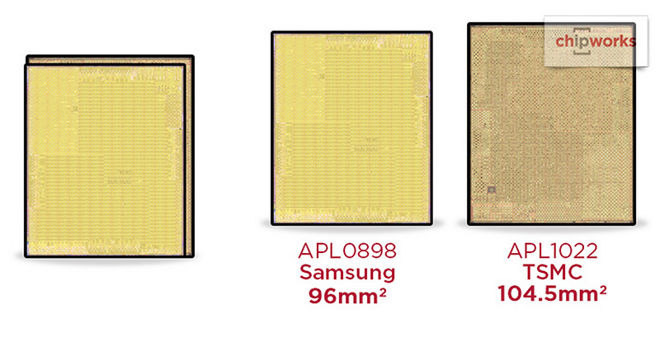Trying to quell rumors, Apple on Thursday issued a statement claiming there is little difference in the battery life of iPhones using A9 chips made by TSMC versus those made by Samsung.
Various anecdotes and Geekbench tests posted online suggested that the gap could be as much as two hours, but an Apple spokesperson told TechCrunch that the variance is small.
"Our testing and customer data show the actual battery life of the iPhone 6s and iPhone 6s Plus, even taking into account variable component differences, vary within just 2-3% of each other," the person said.
The representative blasted "certain manufactured lab tests" as "unrealistic," since they force processors to run at high CPU usage until a battery is drained.
"It's a misleading way to measure real-world battery life," Apple suggested.
Accounts have generally pointed to TSMC-based iPhones lasting longer. The supplier uses a 16-nanometer FinFET process to build its version of the A9, whereas Samsung is believed to use 14-nanometer technology. Energy efficiency normally increases as an inverse function of semiconductor fabrication size.
Apple's dependence on two different A9 manufacturers is likely a result of needing enough chips to meet demand. The strategy may also be a way of forcing price competition, and having a fallback in case of production problems.
 Roger Fingas
Roger Fingas








 Marko Zivkovic
Marko Zivkovic
 Christine McKee
Christine McKee
 Andrew Orr
Andrew Orr
 Andrew O'Hara
Andrew O'Hara
 William Gallagher
William Gallagher

 Mike Wuerthele
Mike Wuerthele
 Bon Adamson
Bon Adamson


-m.jpg)



53 Comments
Nanometergate.
Nanometergate.
Meaning, really, REALLY, tiny gate.
Energy efficiency normally increases as an inverse function of semiconductor fabrication size.
I was under the impression that the opposite was true. So smaller die size results in worse energy efficiency?
I was under the impression that the opposite was true. So smaller die size results in worse energy efficiency?
The article and you are right (your impression, that smaller consumes less energy). As the die goes down in size, the energy efficiency goes up; thus, an inverse relationship.
I hope TSMC can produce enough A10s for the iPhone 7.
I was under the impression that the opposite was true. So smaller die size results in worse energy efficiency?
Were they both to INCREASE together then 'the opposite would be true'. efficiency INCREASE: size DECREASE: INVERSE.
And they don't and it isn't.